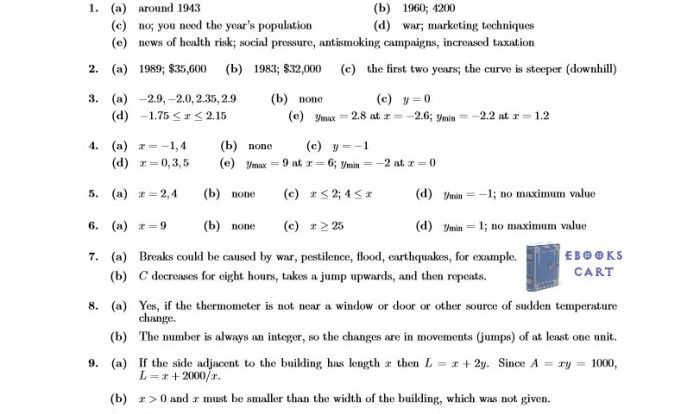Welcome to the realm of Big Ideas Math Modeling Real Life Answer Key, where mathematical concepts transcend theoretical boundaries and empower us to tackle real-world challenges. This comprehensive guide unlocks the secrets of mathematical modeling, providing a roadmap for understanding and solving practical problems that span diverse domains.
As we delve into the intricacies of mathematical modeling, we will explore the fundamental principles that underpin its application in various fields, from science and engineering to economics and finance. By unraveling the modeling process, we gain insights into the techniques used to identify problems, gather data, formulate models, and validate their accuracy.
1. Key Concepts
Mathematical modeling plays a crucial role in understanding and solving real-world problems. It involves creating mathematical representations of real-world systems, phenomena, or processes to gain insights, make predictions, and optimize outcomes.
Mathematical models help us simplify complex systems, identify key relationships, and quantify the effects of different variables. They allow us to test hypotheses, simulate scenarios, and explore alternative solutions without the need for costly or time-consuming experimentation.
Examples of Mathematical Models in Various Fields
- Science:Climate models predict weather patterns and climate change impacts.
- Engineering:Structural models ensure the safety and stability of bridges and buildings.
- Economics:Econometric models forecast economic trends and analyze the impact of policies.
2. Modeling Process

The mathematical modeling process typically involves the following steps:
Identifying and Defining the Problem, Big ideas math modeling real life answer key
Clearly defining the problem statement and the objectives of the model is crucial. This involves understanding the system’s behavior, constraints, and desired outcomes.
Gathering Data
Relevant data from experiments, observations, or historical records is collected to inform the model’s parameters and assumptions.
Formulating the Model
Based on the gathered data and the understanding of the system, a mathematical model is developed. This involves choosing appropriate mathematical equations, variables, and relationships.
Solving and Validating the Model
The model is solved using analytical or numerical methods to obtain solutions or predictions. The model’s accuracy and reliability are then validated through comparison with experimental data or other known outcomes.
3. Real-Life Applications
Mathematical models have found widespread applications in various domains, including:
Healthcare
- Predicting disease outbreaks and optimizing treatment strategies.
- Modeling the spread of infectious diseases and evaluating vaccination programs.
Transportation
- Optimizing traffic flow and reducing congestion in urban areas.
- Designing efficient transportation systems, including public transportation and logistics.
Finance
- Forecasting stock prices and market trends.
- Assessing risk and optimizing investment portfolios.
4. Model Evaluation and Refinement
Evaluating and refining mathematical models is essential to ensure their accuracy and reliability. This involves:
Assessing Accuracy and Reliability
Comparing the model’s predictions with real-world data and assessing its ability to capture the system’s behavior.
Improving Models
Incorporating new data, modifying assumptions, or refining the model structure to enhance its accuracy and predictive power.
5. Ethical Considerations: Big Ideas Math Modeling Real Life Answer Key
Using mathematical models in decision-making requires careful consideration of ethical implications:
Potential Biases and Limitations
Recognizing that models are simplifications of reality and may have limitations or biases due to data availability, assumptions, or model structure.
Responsible Use
Ensuring that models are used transparently, with clear communication of their limitations and uncertainties, to avoid misleading or harmful outcomes.
Clarifying Questions
What is the significance of mathematical modeling in real-life applications?
Mathematical modeling provides a powerful tool for understanding and solving complex problems in diverse fields. It enables us to represent real-world phenomena mathematically, allowing for analysis, prediction, and optimization.
What are the key steps involved in the mathematical modeling process?
The mathematical modeling process typically involves problem identification, data gathering, model formulation, model solving, and model validation. Each step requires careful consideration and expertise.
How can mathematical models be evaluated and refined?
Evaluating and refining mathematical models is crucial to ensure their accuracy and reliability. This involves assessing model performance, identifying potential biases, and incorporating new data or modifying assumptions to improve model outcomes.





